Literature Review: Pros and Cons of Laptop Use in Classrooms
VerifiedAdded on 2020/06/05
|8
|1832
|60
Literature Review
AI Summary
This literature review examines the impact of laptop usage in higher education classrooms. It begins with an introduction outlining the purpose and scope, followed by a historical background of laptop integration in education. The main body explores methodologies, contrasting mainstream and alternative perspectives on laptop use, and highlighting both the advantages (access to resources, enhanced understanding, group work) and disadvantages (distraction, non-academic use). The review synthesizes research findings, including studies on student behavior and academic performance, and concludes with a balanced assessment of laptop use, emphasizing the need for guidelines to mitigate potential drawbacks. The review references several books and journal articles, offering a comprehensive overview of the topic and its implications for teaching and learning.
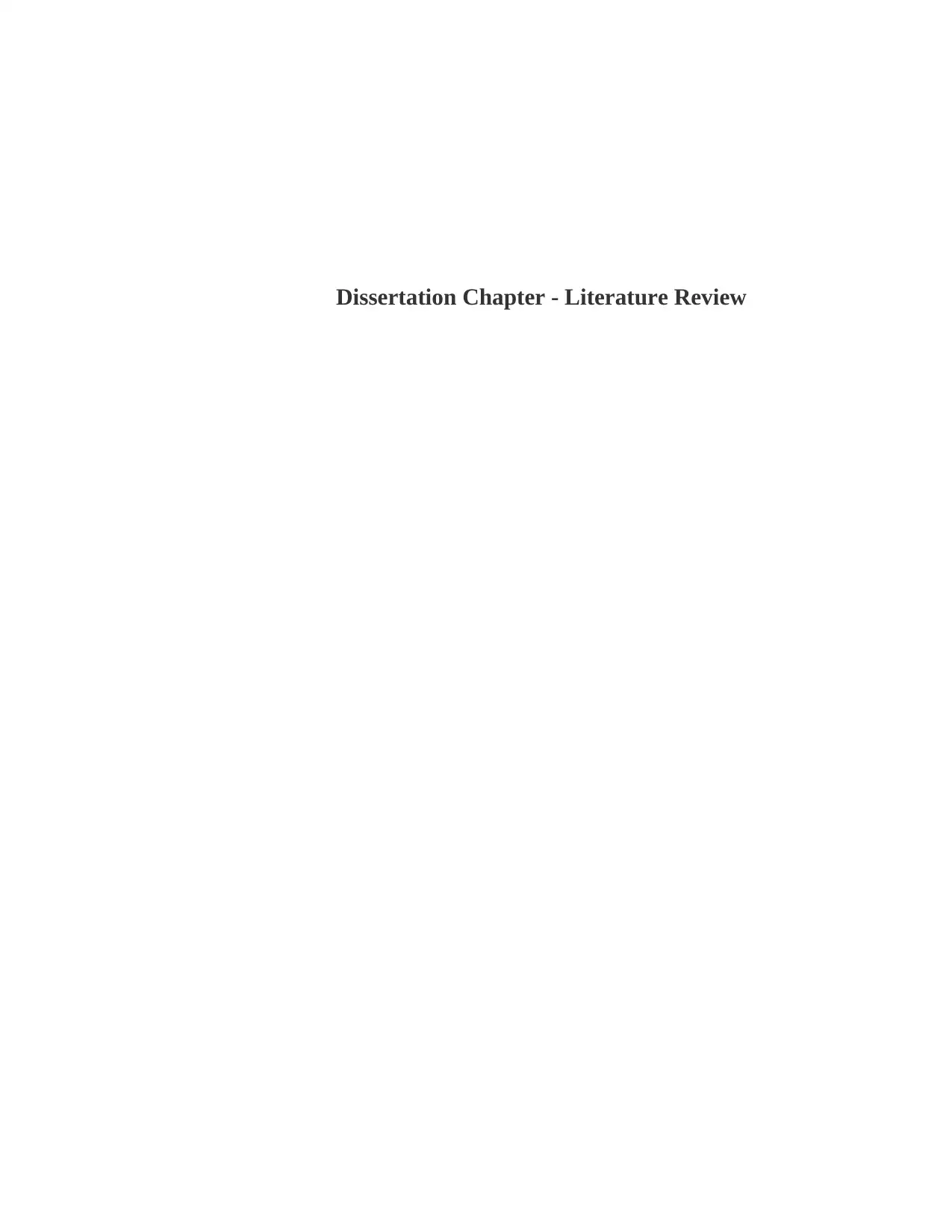
Dissertation Chapter - Literature Review
Paraphrase This Document
Need a fresh take? Get an instant paraphrase of this document with our AI Paraphraser
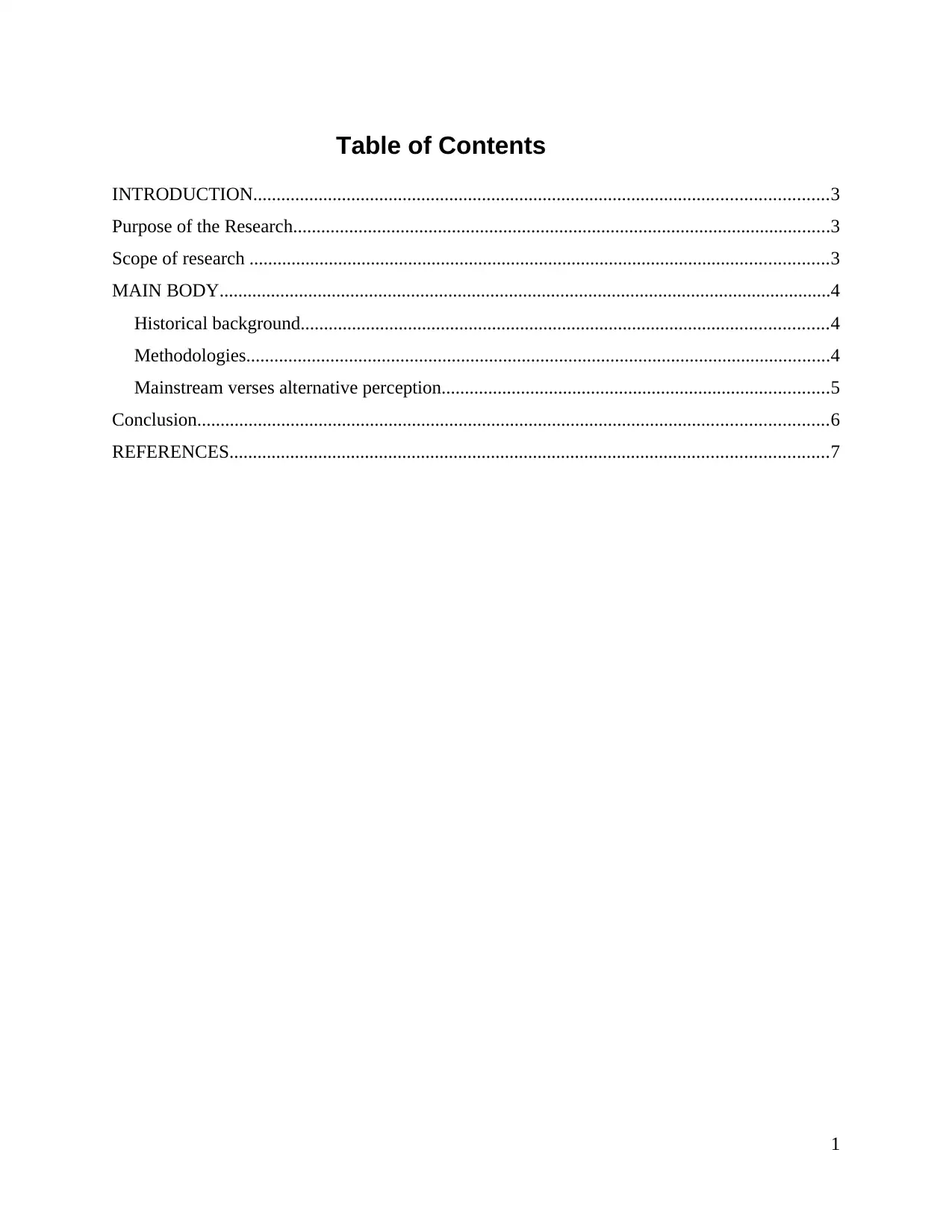
Table of Contents
INTRODUCTION...........................................................................................................................3
Purpose of the Research...................................................................................................................3
Scope of research ............................................................................................................................3
MAIN BODY...................................................................................................................................4
Historical background.................................................................................................................4
Methodologies.............................................................................................................................4
Mainstream verses alternative perception...................................................................................5
Conclusion.......................................................................................................................................6
REFERENCES................................................................................................................................7
1
INTRODUCTION...........................................................................................................................3
Purpose of the Research...................................................................................................................3
Scope of research ............................................................................................................................3
MAIN BODY...................................................................................................................................4
Historical background.................................................................................................................4
Methodologies.............................................................................................................................4
Mainstream verses alternative perception...................................................................................5
Conclusion.......................................................................................................................................6
REFERENCES................................................................................................................................7
1
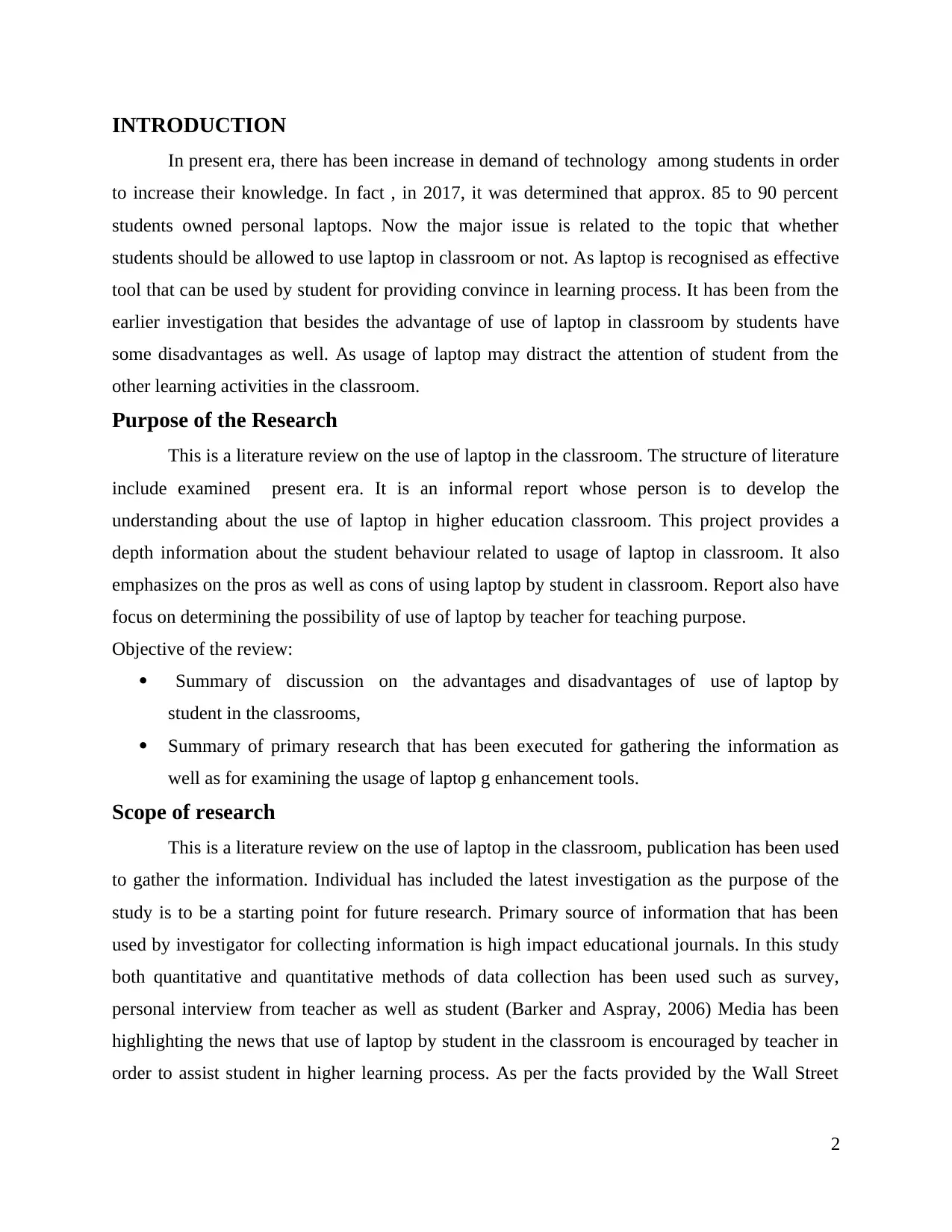
INTRODUCTION
In present era, there has been increase in demand of technology among students in order
to increase their knowledge. In fact , in 2017, it was determined that approx. 85 to 90 percent
students owned personal laptops. Now the major issue is related to the topic that whether
students should be allowed to use laptop in classroom or not. As laptop is recognised as effective
tool that can be used by student for providing convince in learning process. It has been from the
earlier investigation that besides the advantage of use of laptop in classroom by students have
some disadvantages as well. As usage of laptop may distract the attention of student from the
other learning activities in the classroom.
Purpose of the Research
This is a literature review on the use of laptop in the classroom. The structure of literature
include examined present era. It is an informal report whose person is to develop the
understanding about the use of laptop in higher education classroom. This project provides a
depth information about the student behaviour related to usage of laptop in classroom. It also
emphasizes on the pros as well as cons of using laptop by student in classroom. Report also have
focus on determining the possibility of use of laptop by teacher for teaching purpose.
Objective of the review:
Summary of discussion on the advantages and disadvantages of use of laptop by
student in the classrooms,
Summary of primary research that has been executed for gathering the information as
well as for examining the usage of laptop g enhancement tools.
Scope of research
This is a literature review on the use of laptop in the classroom, publication has been used
to gather the information. Individual has included the latest investigation as the purpose of the
study is to be a starting point for future research. Primary source of information that has been
used by investigator for collecting information is high impact educational journals. In this study
both quantitative and quantitative methods of data collection has been used such as survey,
personal interview from teacher as well as student (Barker and Aspray, 2006) Media has been
highlighting the news that use of laptop by student in the classroom is encouraged by teacher in
order to assist student in higher learning process. As per the facts provided by the Wall Street
2
In present era, there has been increase in demand of technology among students in order
to increase their knowledge. In fact , in 2017, it was determined that approx. 85 to 90 percent
students owned personal laptops. Now the major issue is related to the topic that whether
students should be allowed to use laptop in classroom or not. As laptop is recognised as effective
tool that can be used by student for providing convince in learning process. It has been from the
earlier investigation that besides the advantage of use of laptop in classroom by students have
some disadvantages as well. As usage of laptop may distract the attention of student from the
other learning activities in the classroom.
Purpose of the Research
This is a literature review on the use of laptop in the classroom. The structure of literature
include examined present era. It is an informal report whose person is to develop the
understanding about the use of laptop in higher education classroom. This project provides a
depth information about the student behaviour related to usage of laptop in classroom. It also
emphasizes on the pros as well as cons of using laptop by student in classroom. Report also have
focus on determining the possibility of use of laptop by teacher for teaching purpose.
Objective of the review:
Summary of discussion on the advantages and disadvantages of use of laptop by
student in the classrooms,
Summary of primary research that has been executed for gathering the information as
well as for examining the usage of laptop g enhancement tools.
Scope of research
This is a literature review on the use of laptop in the classroom, publication has been used
to gather the information. Individual has included the latest investigation as the purpose of the
study is to be a starting point for future research. Primary source of information that has been
used by investigator for collecting information is high impact educational journals. In this study
both quantitative and quantitative methods of data collection has been used such as survey,
personal interview from teacher as well as student (Barker and Aspray, 2006) Media has been
highlighting the news that use of laptop by student in the classroom is encouraged by teacher in
order to assist student in higher learning process. As per the facts provided by the Wall Street
2
⊘ This is a preview!⊘
Do you want full access?
Subscribe today to unlock all pages.

Trusted by 1+ million students worldwide
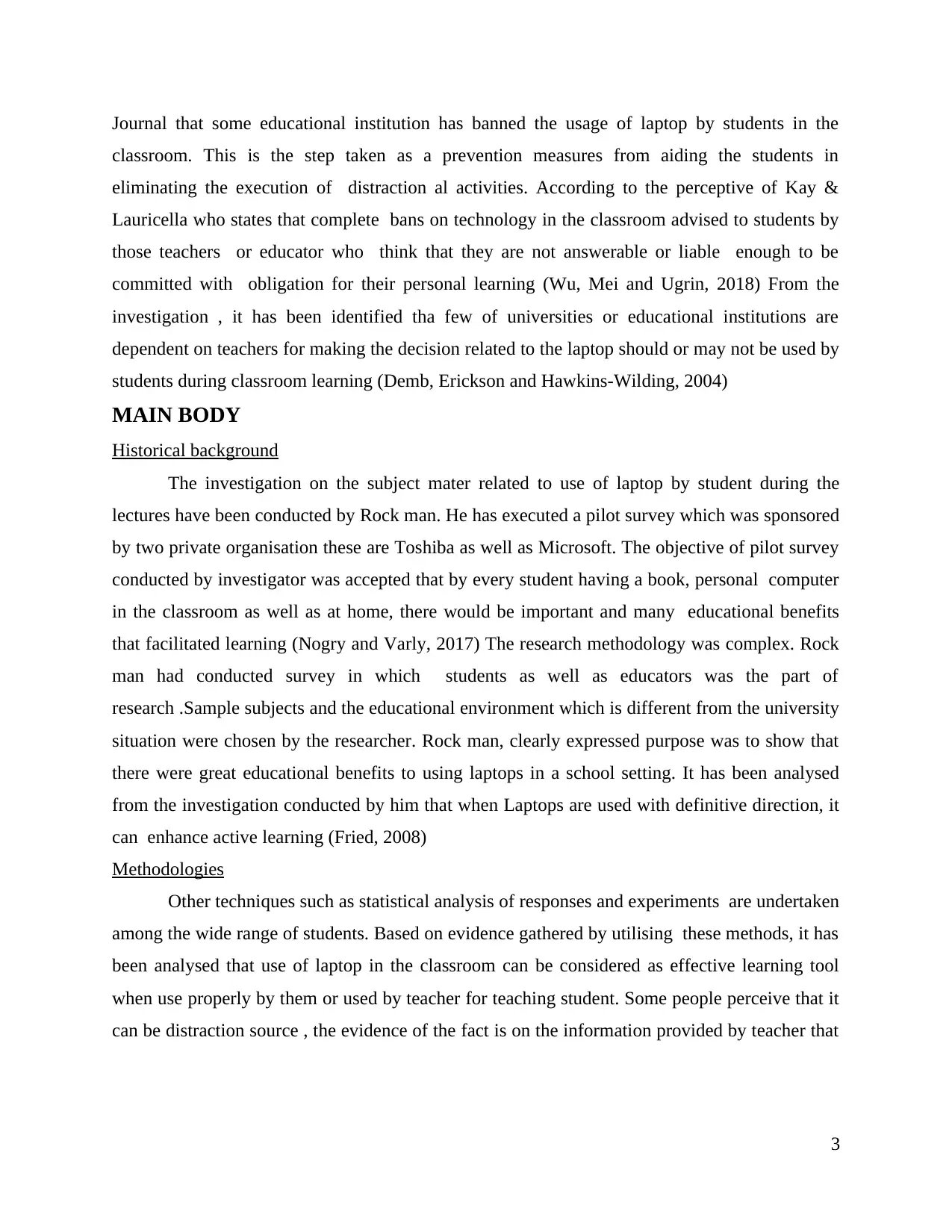
Journal that some educational institution has banned the usage of laptop by students in the
classroom. This is the step taken as a prevention measures from aiding the students in
eliminating the execution of distraction al activities. According to the perceptive of Kay &
Lauricella who states that complete bans on technology in the classroom advised to students by
those teachers or educator who think that they are not answerable or liable enough to be
committed with obligation for their personal learning (Wu, Mei and Ugrin, 2018) From the
investigation , it has been identified tha few of universities or educational institutions are
dependent on teachers for making the decision related to the laptop should or may not be used by
students during classroom learning (Demb, Erickson and Hawkins-Wilding, 2004)
MAIN BODY
Historical background
The investigation on the subject mater related to use of laptop by student during the
lectures have been conducted by Rock man. He has executed a pilot survey which was sponsored
by two private organisation these are Toshiba as well as Microsoft. The objective of pilot survey
conducted by investigator was accepted that by every student having a book, personal computer
in the classroom as well as at home, there would be important and many educational benefits
that facilitated learning (Nogry and Varly, 2017) The research methodology was complex. Rock
man had conducted survey in which students as well as educators was the part of
research .Sample subjects and the educational environment which is different from the university
situation were chosen by the researcher. Rock man, clearly expressed purpose was to show that
there were great educational benefits to using laptops in a school setting. It has been analysed
from the investigation conducted by him that when Laptops are used with definitive direction, it
can enhance active learning (Fried, 2008)
Methodologies
Other techniques such as statistical analysis of responses and experiments are undertaken
among the wide range of students. Based on evidence gathered by utilising these methods, it has
been analysed that use of laptop in the classroom can be considered as effective learning tool
when use properly by them or used by teacher for teaching student. Some people perceive that it
can be distraction source , the evidence of the fact is on the information provided by teacher that
3
classroom. This is the step taken as a prevention measures from aiding the students in
eliminating the execution of distraction al activities. According to the perceptive of Kay &
Lauricella who states that complete bans on technology in the classroom advised to students by
those teachers or educator who think that they are not answerable or liable enough to be
committed with obligation for their personal learning (Wu, Mei and Ugrin, 2018) From the
investigation , it has been identified tha few of universities or educational institutions are
dependent on teachers for making the decision related to the laptop should or may not be used by
students during classroom learning (Demb, Erickson and Hawkins-Wilding, 2004)
MAIN BODY
Historical background
The investigation on the subject mater related to use of laptop by student during the
lectures have been conducted by Rock man. He has executed a pilot survey which was sponsored
by two private organisation these are Toshiba as well as Microsoft. The objective of pilot survey
conducted by investigator was accepted that by every student having a book, personal computer
in the classroom as well as at home, there would be important and many educational benefits
that facilitated learning (Nogry and Varly, 2017) The research methodology was complex. Rock
man had conducted survey in which students as well as educators was the part of
research .Sample subjects and the educational environment which is different from the university
situation were chosen by the researcher. Rock man, clearly expressed purpose was to show that
there were great educational benefits to using laptops in a school setting. It has been analysed
from the investigation conducted by him that when Laptops are used with definitive direction, it
can enhance active learning (Fried, 2008)
Methodologies
Other techniques such as statistical analysis of responses and experiments are undertaken
among the wide range of students. Based on evidence gathered by utilising these methods, it has
been analysed that use of laptop in the classroom can be considered as effective learning tool
when use properly by them or used by teacher for teaching student. Some people perceive that it
can be distraction source , the evidence of the fact is on the information provided by teacher that
3
Paraphrase This Document
Need a fresh take? Get an instant paraphrase of this document with our AI Paraphraser
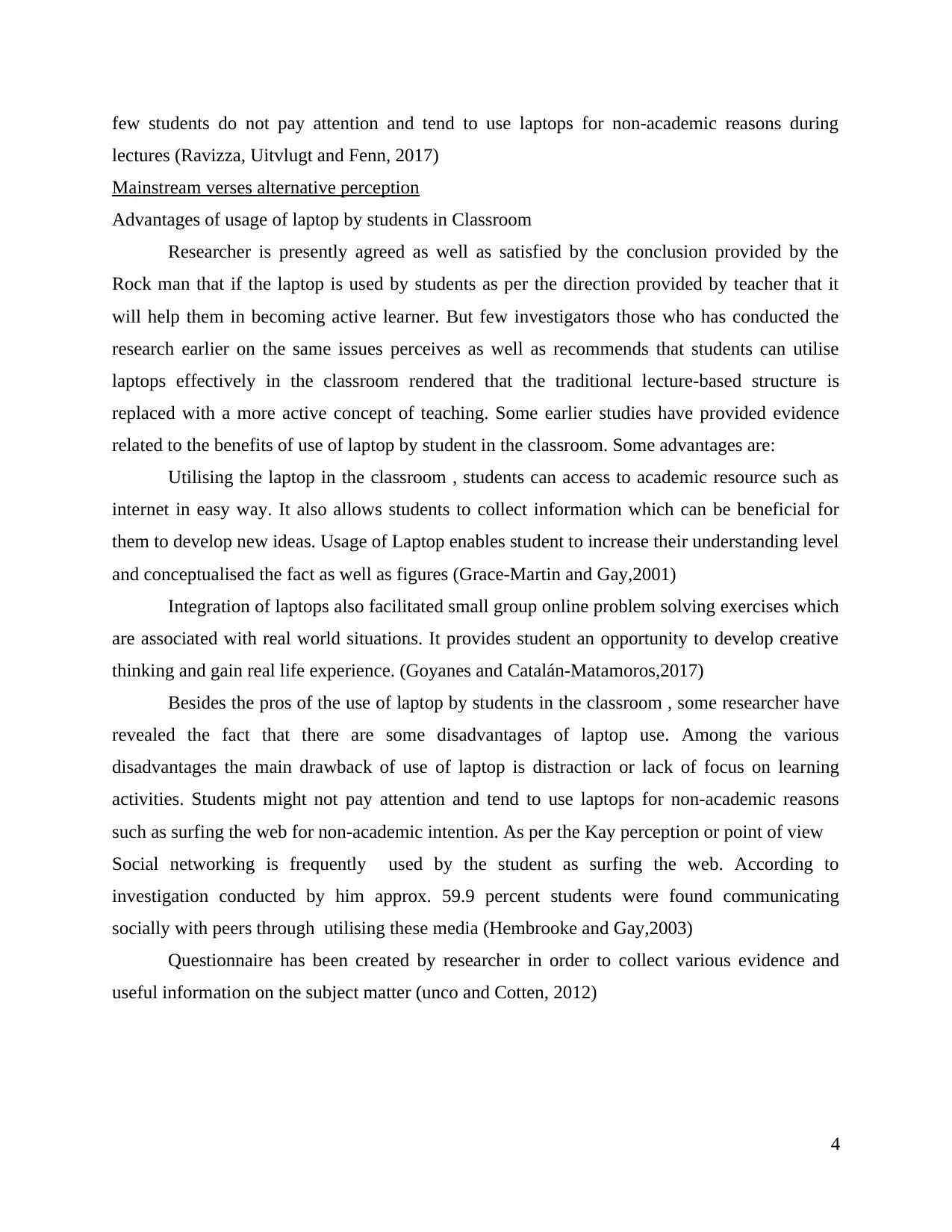
few students do not pay attention and tend to use laptops for non-academic reasons during
lectures (Ravizza, Uitvlugt and Fenn, 2017)
Mainstream verses alternative perception
Advantages of usage of laptop by students in Classroom
Researcher is presently agreed as well as satisfied by the conclusion provided by the
Rock man that if the laptop is used by students as per the direction provided by teacher that it
will help them in becoming active learner. But few investigators those who has conducted the
research earlier on the same issues perceives as well as recommends that students can utilise
laptops effectively in the classroom rendered that the traditional lecture-based structure is
replaced with a more active concept of teaching. Some earlier studies have provided evidence
related to the benefits of use of laptop by student in the classroom. Some advantages are:
Utilising the laptop in the classroom , students can access to academic resource such as
internet in easy way. It also allows students to collect information which can be beneficial for
them to develop new ideas. Usage of Laptop enables student to increase their understanding level
and conceptualised the fact as well as figures (Grace-Martin and Gay,2001)
Integration of laptops also facilitated small group online problem solving exercises which
are associated with real world situations. It provides student an opportunity to develop creative
thinking and gain real life experience. (Goyanes and Catalán-Matamoros,2017)
Besides the pros of the use of laptop by students in the classroom , some researcher have
revealed the fact that there are some disadvantages of laptop use. Among the various
disadvantages the main drawback of use of laptop is distraction or lack of focus on learning
activities. Students might not pay attention and tend to use laptops for non-academic reasons
such as surfing the web for non-academic intention. As per the Kay perception or point of view
Social networking is frequently used by the student as surfing the web. According to
investigation conducted by him approx. 59.9 percent students were found communicating
socially with peers through utilising these media (Hembrooke and Gay,2003)
Questionnaire has been created by researcher in order to collect various evidence and
useful information on the subject matter (unco and Cotten, 2012)
4
lectures (Ravizza, Uitvlugt and Fenn, 2017)
Mainstream verses alternative perception
Advantages of usage of laptop by students in Classroom
Researcher is presently agreed as well as satisfied by the conclusion provided by the
Rock man that if the laptop is used by students as per the direction provided by teacher that it
will help them in becoming active learner. But few investigators those who has conducted the
research earlier on the same issues perceives as well as recommends that students can utilise
laptops effectively in the classroom rendered that the traditional lecture-based structure is
replaced with a more active concept of teaching. Some earlier studies have provided evidence
related to the benefits of use of laptop by student in the classroom. Some advantages are:
Utilising the laptop in the classroom , students can access to academic resource such as
internet in easy way. It also allows students to collect information which can be beneficial for
them to develop new ideas. Usage of Laptop enables student to increase their understanding level
and conceptualised the fact as well as figures (Grace-Martin and Gay,2001)
Integration of laptops also facilitated small group online problem solving exercises which
are associated with real world situations. It provides student an opportunity to develop creative
thinking and gain real life experience. (Goyanes and Catalán-Matamoros,2017)
Besides the pros of the use of laptop by students in the classroom , some researcher have
revealed the fact that there are some disadvantages of laptop use. Among the various
disadvantages the main drawback of use of laptop is distraction or lack of focus on learning
activities. Students might not pay attention and tend to use laptops for non-academic reasons
such as surfing the web for non-academic intention. As per the Kay perception or point of view
Social networking is frequently used by the student as surfing the web. According to
investigation conducted by him approx. 59.9 percent students were found communicating
socially with peers through utilising these media (Hembrooke and Gay,2003)
Questionnaire has been created by researcher in order to collect various evidence and
useful information on the subject matter (unco and Cotten, 2012)
4
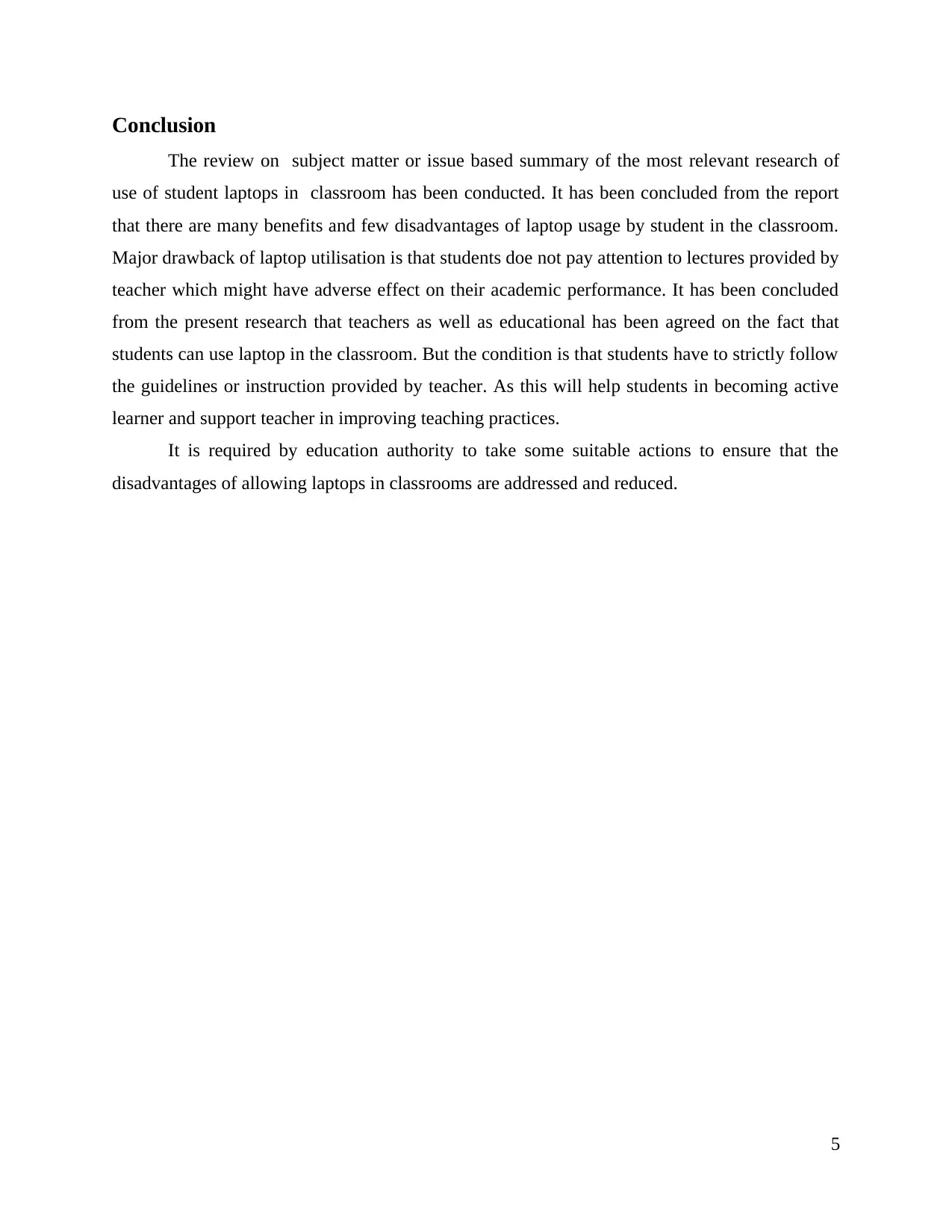
Conclusion
The review on subject matter or issue based summary of the most relevant research of
use of student laptops in classroom has been conducted. It has been concluded from the report
that there are many benefits and few disadvantages of laptop usage by student in the classroom.
Major drawback of laptop utilisation is that students doe not pay attention to lectures provided by
teacher which might have adverse effect on their academic performance. It has been concluded
from the present research that teachers as well as educational has been agreed on the fact that
students can use laptop in the classroom. But the condition is that students have to strictly follow
the guidelines or instruction provided by teacher. As this will help students in becoming active
learner and support teacher in improving teaching practices.
It is required by education authority to take some suitable actions to ensure that the
disadvantages of allowing laptops in classrooms are addressed and reduced.
5
The review on subject matter or issue based summary of the most relevant research of
use of student laptops in classroom has been conducted. It has been concluded from the report
that there are many benefits and few disadvantages of laptop usage by student in the classroom.
Major drawback of laptop utilisation is that students doe not pay attention to lectures provided by
teacher which might have adverse effect on their academic performance. It has been concluded
from the present research that teachers as well as educational has been agreed on the fact that
students can use laptop in the classroom. But the condition is that students have to strictly follow
the guidelines or instruction provided by teacher. As this will help students in becoming active
learner and support teacher in improving teaching practices.
It is required by education authority to take some suitable actions to ensure that the
disadvantages of allowing laptops in classrooms are addressed and reduced.
5
⊘ This is a preview!⊘
Do you want full access?
Subscribe today to unlock all pages.

Trusted by 1+ million students worldwide
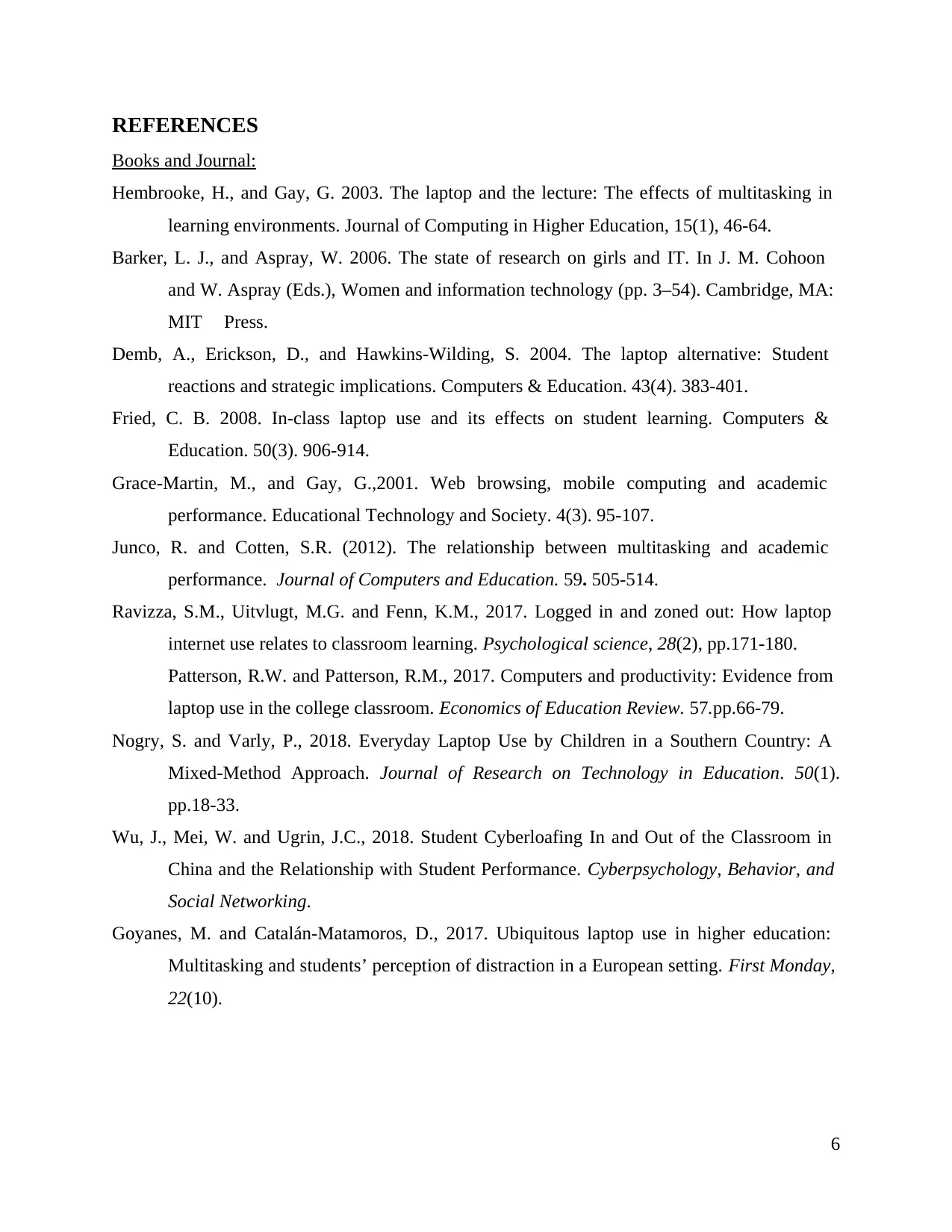
REFERENCES
Books and Journal:
Hembrooke, H., and Gay, G. 2003. The laptop and the lecture: The effects of multitasking in
learning environments. Journal of Computing in Higher Education, 15(1), 46-64.
Barker, L. J., and Aspray, W. 2006. The state of research on girls and IT. In J. M. Cohoon
and W. Aspray (Eds.), Women and information technology (pp. 3–54). Cambridge, MA:
MIT Press.
Demb, A., Erickson, D., and Hawkins-Wilding, S. 2004. The laptop alternative: Student
reactions and strategic implications. Computers & Education. 43(4). 383-401.
Fried, C. B. 2008. In-class laptop use and its effects on student learning. Computers &
Education. 50(3). 906-914.
Grace-Martin, M., and Gay, G.,2001. Web browsing, mobile computing and academic
performance. Educational Technology and Society. 4(3). 95-107.
Junco, R. and Cotten, S.R. (2012). The relationship between multitasking and academic
performance. Journal of Computers and Education. 59. 505-514.
Ravizza, S.M., Uitvlugt, M.G. and Fenn, K.M., 2017. Logged in and zoned out: How laptop
internet use relates to classroom learning. Psychological science, 28(2), pp.171-180.
Patterson, R.W. and Patterson, R.M., 2017. Computers and productivity: Evidence from
laptop use in the college classroom. Economics of Education Review. 57.pp.66-79.
Nogry, S. and Varly, P., 2018. Everyday Laptop Use by Children in a Southern Country: A
Mixed-Method Approach. Journal of Research on Technology in Education. 50(1).
pp.18-33.
Wu, J., Mei, W. and Ugrin, J.C., 2018. Student Cyberloafing In and Out of the Classroom in
China and the Relationship with Student Performance. Cyberpsychology, Behavior, and
Social Networking.
Goyanes, M. and Catalán-Matamoros, D., 2017. Ubiquitous laptop use in higher education:
Multitasking and students’ perception of distraction in a European setting. First Monday,
22(10).
6
Books and Journal:
Hembrooke, H., and Gay, G. 2003. The laptop and the lecture: The effects of multitasking in
learning environments. Journal of Computing in Higher Education, 15(1), 46-64.
Barker, L. J., and Aspray, W. 2006. The state of research on girls and IT. In J. M. Cohoon
and W. Aspray (Eds.), Women and information technology (pp. 3–54). Cambridge, MA:
MIT Press.
Demb, A., Erickson, D., and Hawkins-Wilding, S. 2004. The laptop alternative: Student
reactions and strategic implications. Computers & Education. 43(4). 383-401.
Fried, C. B. 2008. In-class laptop use and its effects on student learning. Computers &
Education. 50(3). 906-914.
Grace-Martin, M., and Gay, G.,2001. Web browsing, mobile computing and academic
performance. Educational Technology and Society. 4(3). 95-107.
Junco, R. and Cotten, S.R. (2012). The relationship between multitasking and academic
performance. Journal of Computers and Education. 59. 505-514.
Ravizza, S.M., Uitvlugt, M.G. and Fenn, K.M., 2017. Logged in and zoned out: How laptop
internet use relates to classroom learning. Psychological science, 28(2), pp.171-180.
Patterson, R.W. and Patterson, R.M., 2017. Computers and productivity: Evidence from
laptop use in the college classroom. Economics of Education Review. 57.pp.66-79.
Nogry, S. and Varly, P., 2018. Everyday Laptop Use by Children in a Southern Country: A
Mixed-Method Approach. Journal of Research on Technology in Education. 50(1).
pp.18-33.
Wu, J., Mei, W. and Ugrin, J.C., 2018. Student Cyberloafing In and Out of the Classroom in
China and the Relationship with Student Performance. Cyberpsychology, Behavior, and
Social Networking.
Goyanes, M. and Catalán-Matamoros, D., 2017. Ubiquitous laptop use in higher education:
Multitasking and students’ perception of distraction in a European setting. First Monday,
22(10).
6
Paraphrase This Document
Need a fresh take? Get an instant paraphrase of this document with our AI Paraphraser

7
1 out of 8
Related Documents
Your All-in-One AI-Powered Toolkit for Academic Success.
+13062052269
info@desklib.com
Available 24*7 on WhatsApp / Email
![[object Object]](/_next/static/media/star-bottom.7253800d.svg)
Unlock your academic potential
Copyright © 2020–2025 A2Z Services. All Rights Reserved. Developed and managed by ZUCOL.





